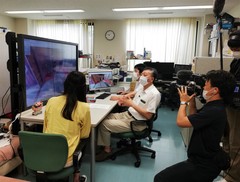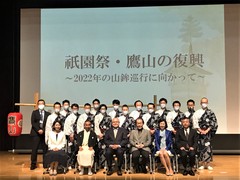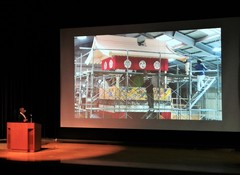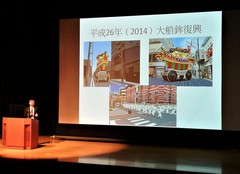-
 16
17
18
19
20
21
22
23
24
25
26
16
17
18
19
20
21
22
23
24
25
26
 [イベント情報]September 21, 2021(Tue)
[イベント情報]September 21, 2021(Tue)Project Overview:
At the center of this project, which involved Bachelor and Master students of Japanology at Goethe University Frankfurt, was the On Edo ezu (御江戸絵図) from the ARC database 'Maps of Japan from the Collection of Sir Hugh and Lady Cortazzi'.
Drawing on maps, guidebooks, and colored woodblock prints, this project attempted to correlate various sources of both geographical and visual experience and knowledge to hypothetically reconstruct how they might have shaped the late Edo period consumer's consciousness based on the materials accessible to them.
→ Click here to access the project website. Professor Kinski, thank you very much for your time. As the leader of the FY2020 ARC-iJAC project 'Edo Period Map goes Digital - The On Edo ezu as an Interactive Resource', could you tell us about your motivation to start this project?
Professor Kinski, thank you very much for your time. As the leader of the FY2020 ARC-iJAC project 'Edo Period Map goes Digital - The On Edo ezu as an Interactive Resource', could you tell us about your motivation to start this project?Prof. Kinski: I began to develop a strong interest in Digital Humanities (DH) in 2012 when I saw a presentation by Bettina Gramlich-Oka--a colleague at Sophia University--about creating an interactive biographic database as part of her interest in social network analysis.
Striving to incorporate text mining, topic modeling, or semantic network analysis in my approach to Edo period intellectual history, I have been making efforts to raise the interest amongst students in the approaches towards Japanese sources derived from DH.
Frankfurt University owns a small collection of printed books covering the period between 1650 and 1850, our 'Edo bunko' which we use for exercises in the classroom to decipher and transcribe larger quantities of text.
A talented student of mine, Koray Birenheide, created a program called 'DemiScript' that allows us to work with source material--whether premodern, modern, textual or visual--and to present the results of our transcription efforts. A far more advanced tool than expected, I was convinced it could serve as a platform for a larger, more ambitious classroom project.
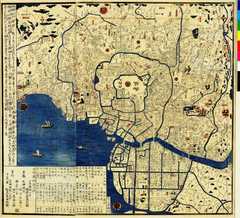
The ARC-iJAC provided a timely opportunity to put our plan into action by drawing on the materials in the ARC databases and combining the first-hand exploration of primary sources with concerns from urban infrastructure history and art history.
Read more>>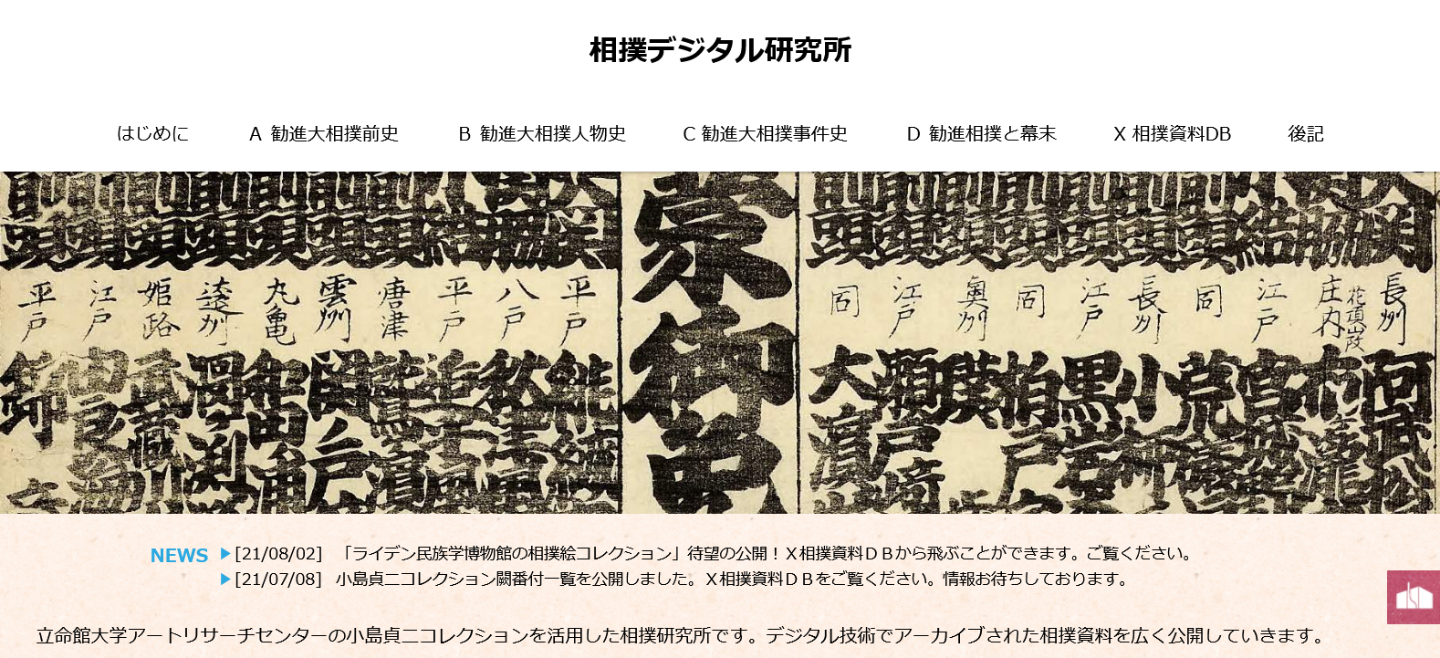
The Art Research Center (ARC), Ritsumeikan University, is pleased to announce the launch of the Sumo Digital Institute within the ARC Virtual Institute, along with the release of the online database of the Teiji Kojima Collection--a treasure trove of sumo banzuke and old sumo documents.
The ARC has been working to create a digital archive of materials related to the history of sumo collected by the late Teiji Kojima, a renowned scholar of sumo history. Along with the release of his collection in June, we decided to publish the results of our research in sumo history under the Sumo Digital Institute.
The Teiji Kojima Collection consists of approximately 1,000 paper documents and dozens of volumes of old sumo-related materials, mainly sumo banzuke, covering a total of 264 years from 1742 (mid-Edo period) to 2006. These digital images are now accessible online at any time.
In addition to browsing the digitized materials, the Sumo Digital Institute offers an online exhibition. It is an attempt to bring to light the many facets of Edo-period kanjin-zumo tournaments by picking up sumo-related articles from the Bukō nenpyō--a compilation of Edo-period events in chronological order--and linking them to sumo banzuke related to the events from the Teiji Kojima Collection, ukiyo-e prints in the Ukiyo-e Portal Database, and materials from the Early Japanese Books Database.
We hope that this online exhibition will encourage people to take an interest in the world of kanjin-zumo that is very different from today.
The exhibition not only links to the Kojima Collection but also to sumo paintings in the Japanese Collection of the Museum Volkenkunde, Leiden, available in the ARC Virtual Institute.
The ukiyo-e paintings that traveled to the Netherlands as soon as they were published are beautiful and well-preserved, retaining their original colors. We hope you enjoy them.
The Sumo Digital Institute strives to collect a wide range of visual data and literary materials about sumo from the Edo period to the modern era and make them available to the public through a digital archive. We hope to raise the public's interest in sumo by releasing these rare sumo materials. [Person in charge: Nozomu Ataka]
[イベント情報]August 12, 2021(Thu)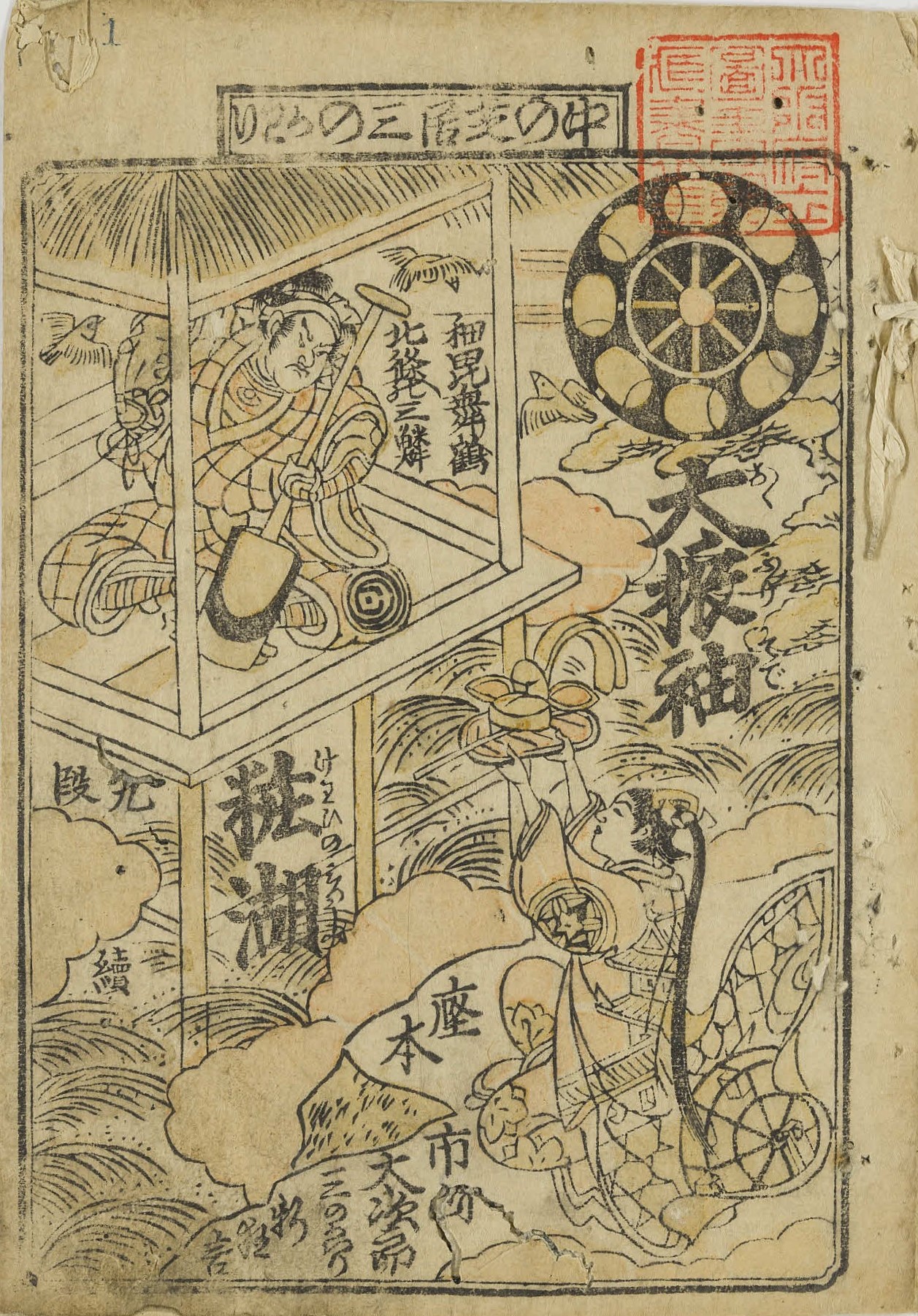
The Art Research Center (ARC), Ritsumeikan University, is pleased to announce the release of the Asahi Shimbun Collection of Shibai Banzuke (Kabuki Playbills), held by the Osaka Prefectural Nakanoshima Library, in our Shibai Banzuke (Kabuki Playbills) Portal Database.
Since the Edo Period, flyers, posters, and programs of kabuki and jōruri plays have provided detailed information about actors, names of the cast, and the content of those plays at that time.
The materials, originally cataloged in the Asahi Shimbun bunko mokuroku (「朝日新聞」文庫目録), were published by the Osaka Prefectural Nakanoshima Library in March 1970. With the permission of the library, the Art Research Center has digitized the materials and re-examined the catalog data, making the images online available through the ARC Shibai Banzuke Database System.
By the end of 2017, the ARC had released around 700 un-cataloged items from the library. This time, we added 1,443 banzuke, bringing the total number of items available in our online database to 2,129.
You can either access these materials from the Osaka Prefectural Nakanoshima Library's website under 'Various Catalogs and Databases' or the ARC Shibai Banzuke Portal Database by selecting the holding institution 'Osaka Prefectural Nakanoshima Library'.
Our Shibai Banzuke Portal Database also comprises banzuke held by other institutions, thus allowing you to browse and compare to find supplementary information.
Furthermore, the Shibai Banzuke Catalog of the Osaka Prefectural Nakanoshima Library, published in October 1968, contains approximately 2,500 items other than the above, which will be digitized in our third project next year. We hope to complete a large-scale database with almost 4,600 items within three years.
The ARC Days were held on July 30 (Fri) & 31 (Sat), 2021. It is an annual event where the faculty members of the Art Research Center, Ritsumeikan University, and international collaborative researchers whose projects have been adopted by the International Joint Digital Archiving Center for Japanese Art and Culture (ARC-iJAC) introduce their research projects in Digital Humanities (DH) in individual presentations.
To prevent the spread of COVID-19, this event was held online via Zoom and broadcasted live on YouTube.
Organizer: International Joint Digital Archiving Center for Japanese Art and Culture (ARC-iJAC), Art Research Center, Ritsumeikan University and Program for Supporting Research Center Formation, Ritsumeikan University
Read more>> Dr. Kok, thank you very much for your time today. As Curator East Asia, you have been at the forefront of this joint research project with the ARC to digitize the extensive Japanese art collection of Wereldmuseum Leiden, part of the National Museum of World Cultures (NMVW).
Dr. Kok, thank you very much for your time today. As Curator East Asia, you have been at the forefront of this joint research project with the ARC to digitize the extensive Japanese art collection of Wereldmuseum Leiden, part of the National Museum of World Cultures (NMVW).What sparked your interest in Japanese art and culture?
Dr. Kok: In high school, I once received a book about Japanese design. It raised my interest to apply at a design academy. Not admitted on my first attempt, I began to study Japanese and enjoyed it so much that I never stopped.
During my studies at Leiden University, I became particularly fond of the kyōka surimono of the 1820s.
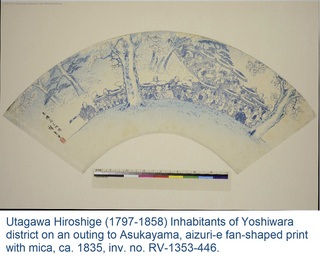
How do you feel about the overall collaboration with the ARC?
Dr. Kok: I am very thankful for our collaboration. The first contact between our museum and the ARC was already established more than ten years ago. During Professor Akama's visits, we would conduct photography together using the 'portable travel kit' he developed to digitize art collections abroad.
The execution of our joint project has never been stagnant, but you can see a continuous improvement year after year. It has also been a valuable learning experience for me to see the mechanisms Professor Akama uses to increase the quality of digitizing artworks.
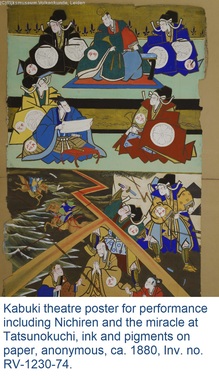
What is the significance of constructing and releasing this database in the ARC Virtual Institute?
Dr. Kok: We need to ensure comprehensive access for researchers to our collection.
Now that we have constructed and interlinked the ARC database with our museum database, the availability of our collection of printed materials to a Japanese-speaking audience is of great significance.
Furthermore, we appreciate the ARC's digital infrastructure for not only searching but also editing the database. The interactivity of the ARC database allows Japanese-speaking researchers to contribute to the database, paving the way for future research.
While our museum database is a more general database for a wide range of objects, the ARC database has a high level of specialization to cater to the specific needs of research in Japanese art and culture, such as ukiyo-e prints and early Japanese books.
Read more>>[イベント情報]July 13, 2021(Tue)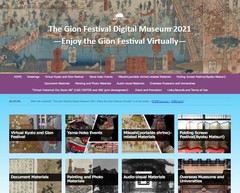 In cooperation with the College of Letters, the International Joint Digital Archiving Center for Japanese Art and Culture (ARC-iJAC), Art Research Center, Ritsumeikan University is delighted to announce the launch of the Gion Festival Digital Museum 2021--Enjoy the Gion Festival Virtually--.
In cooperation with the College of Letters, the International Joint Digital Archiving Center for Japanese Art and Culture (ARC-iJAC), Art Research Center, Ritsumeikan University is delighted to announce the launch of the Gion Festival Digital Museum 2021--Enjoy the Gion Festival Virtually--.The site is a renewal of the Gion Festival Digital Museum 2020 ~The Past, Present, and Future of the Gion Festival~ which was released last year.
This year, the Gion Festival has unfortunately been affected again by the global pandemic, leading to the cancellation of many events, including the Yama-hoko Junko.
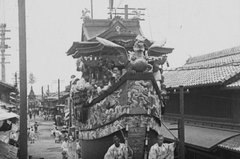
In response to this, we have launched the Gion Festival Digital Museum 2021 where visitors can experience the charm and history of the Gion Festival online.
<<Gion Festival Digital Museum 2021>>
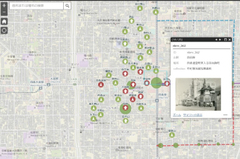
Highlights of the new contents:
1. 2D and 3D maps of virtual Kyoto by ArcGIS Online
2. High-resolution images of hanging scrolls, Gion bayashi, and virtual festival parades
3. App Virtual Historical City Kyoto AR (iOS and Android)
TV coverage:
An interview with Prof. Keiji Yano (ARC Deputy Director) on the Gion Festival Digital Museum 2021 has been broadcasted by NHK Kyoto ニュース630京いちにち on July 16 (Fri), 2021.
→ Watch the video below.
The ARC is dedicated to research, analyze, record, organize, preserve and disseminate the tangibles and intangibles of Japanese cultural heritage. By digital archiving traditional events such as the Gion Festival and making them available to the broad public, the center strives to retain their significance for future generations.
[イベント情報]July 1, 2021(Thu)In anticipation of the return of the Takayama float to the Gion Festival in 2022, a symposium was held by Asahi Shimbun, co-organized by the Art Research Center (ARC), Ritsumeikan University, on June 19, 2021.
The Takayama float boasts a long history of participating in the Yamahoko Junko parade that dates back to the 15th century. However, the float has been absent from the festival since 1826, having suffered from heavy damages caused by natural disasters.
As a result of the continued dedication and determination of the Takayama Preservation Association to revive the Takayama float, the long-cherished wish of the townspeople for the float to return to the Yamahoko Junko after nearly 200 years will finally come true.
The Symposium
At the beginning of the symposium, Mr. Junji Yamada, Head of the Takayama Preservation Association, gave an overview of the reconstruction progress of the float and expressed his joy that it is due to be completed four years earlier than expected.
Then, Prof. Keiji Yano, Deputy Director of the ARC, introduced the center's various activities concerning the digital archiving of the Gion Festival and the Takayama float (→ Gion Festival Digital Museum 2020 and 2021).
He presented CG animation of the rebuilt Takayama float, 2D and 3D maps of festival routes, old videos and photographs from the early Showa era, and 3D see-through visualization models of the festival floats, amongst others.
"As we did last year, the Art Research Center will be making its research results available to the public again from July this year through the Gion Festival Digital Museum 2021, so please look forward to it," expressed Prof. Yano.
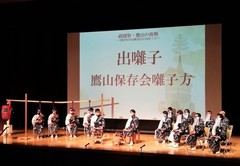
Other distinguished guest speakers included Prof. Shoichi Inoue, Director of the International Research Center for Japanese Studies; Mr. Takashi Minamoto, film director and screenwriter; and Ms. Rieko Morita, Nihonga painter and Affiliate Professor at the Kyoto City University of Arts, with each of them sharing stories about his/her connection with the Gion Festival and the Takayama float.
Concluding the symposium, the hayashikata (Gion Festival musicians) of the Takayama Preservation Association performed ohayashi specific to the float.
Anticipation
"Ever since I was a kid, I have seen the festival floats passing by, accompanied by the creaking of wheels while I stood on the roadside listening to the ohayashi," Mr. Yamada reminisced. "None of us has ever experienced playing the ohayashi on the Takayama float during the festival, so we are all more than excited."
*A full video of the event is available online from July 1 - August 31, 2021 (in Japanese). To watch the video, please register via the following link: https://ciy.digital.asahi.com/ciy/11004163.
[イベント情報]June 25, 2021(Fri)Background:
Kuzushiji is a kind of Japanese cursive script found in early Japanese books (until the mid-Meiji Period).
Due to the different writing styles compared with modern Japanese characters, kuzushiji can be understood only by a minority of trained specialists.
The Art Research Center (ARC), Ritsumeikan University, has developed an educational transcription system with an AI-enabled deciphering support function for kuzushiji to facilitate access to early Japanese books for academic research.
The training course started on May 14, 2021, and has counted participants from 12 countries so far. It is provided free of charge. (→Click here for details on the training course.)Professor Akama, thank you very much for your time today. You have just completed Phase 1 of the kuzushiji training course for beginners and intermediate levels. What is the purpose of your training course?
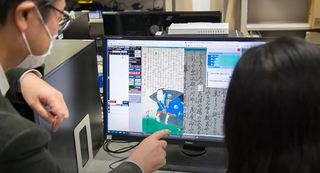 Prof. Akama: We have developed an AI-enabled transcription support system for kuzushiji specifically for educational purposes as part of an industry-academia collaboration with Toppan Printing Co., Ltd. The company kindly provided us with the API (application programming interface) of their kuzushiji recognition system that is powered by deep learning.
Prof. Akama: We have developed an AI-enabled transcription support system for kuzushiji specifically for educational purposes as part of an industry-academia collaboration with Toppan Printing Co., Ltd. The company kindly provided us with the API (application programming interface) of their kuzushiji recognition system that is powered by deep learning.Our purpose is to teach and support students and researchers in utilizing our transcription support system for their academic research projects based on the abundant materials available in the ARC's Early Japanese Books Portal Database. You can freely choose the materials you wish to transcribe from our database--with over 218,000 titles, one of the largest databases of digital-archived early Japanese books in the world.
I have held several workshops on the system, for instance, at the University of Leiden and the University of California, Berkeley. Not able to travel due to the pandemic, I hope to promote the system's usage by offering this online training course.
Read more>>The International Joint Digital Archiving Center for Japanese Art and Culture (ARC-iJAC), Art Research Center, Ritsumeikan University, will be co-hosting the 2021 Annual Conference of the Japan Art Documentation Society (JADS) on June 19 (Sat) and 20 (Sun), 2021.
You are cordially invited to join us.
■ Date:
June 19 (Sat) 13:00 - 17:00
June 20 (Sun) 10:00 - 16:15
■ Participation method:
The conference will be held online.
*Please note that the conference will not be held on the Kinugasa Campus of Ritsumeikan University.
*Details regarding the online access to the conference and the conference proceedings (PDF) will be informed separately.
*Any change in the outline of the conference will be announced via the conference mailing list (ML). If you have not yet registered for the ML, please do so.
■ Participation fee:
Free of charge for both JADS members and non-members.
*A paper version of the proceedings will not be published this year. Please print out the PDF file of the proceedings if required.
■ Registration:
Please register via our application form.
*Upon registration, an automatic email will be sent to you with details to access the conference and the proceedings.
Application deadline: June 18 (Fri), 2021
*This conference is open to both members and non-members, except for the general meeting on the second day.
Organized by: Japan Art Documentation Society (JADS) and the MEXT International Joint Usage / Research Center International Joint Digital Archiving Center for Japanese Art and Culture (ARC-iJAC), Art Research Center, Ritsumeikan University
Supported by: 記録管理学会 、情報処理学会人文科学とコンピュータ研究会、情報知識学会、人文系データベース協議会、全国大学史資料協議会、全国美術館会議、全国歴史資料保存利用機関連絡協議会、専門図書館協議会、デジタルアーカイブ学会、日本アーカイブズ学会、日本アートマネジメント学会、日本デジタル・ヒューマニティーズ学会、日本ミュージアム・マネージメント学会
For inquiries, please contact:
Organizing Committee for the 2021 Annual Conference of the Japan Art Documentation Society
Read more>>
jads_conf2021■googlegroups.com (Please change "■" to "@")[イベント情報]June 11, 2021(Fri)On June 10, 2021, the ARC-iJAC-funded research project of Professor Eriko Hata (Faculty of Humanities and Social Sciences, Shizuoka Eiwa Gakuin University) on the primary sources related to the legend of Urashima in the collection of Itoi Bunko Library in Maizuru City was featured in the evening edition of the Kyoto Shimbun.
The article reported on a different and unexpected turn from the commonly known story on the legend of Urashima Taro from the Edo period that is introduced in an easy-to-understand way by Prof. Hata's research group investigating the Itoi Bunko Library in Maizuru.
 16
17
18
19
20
21
22
23
24
25
26
16
17
18
19
20
21
22
23
24
25
26



